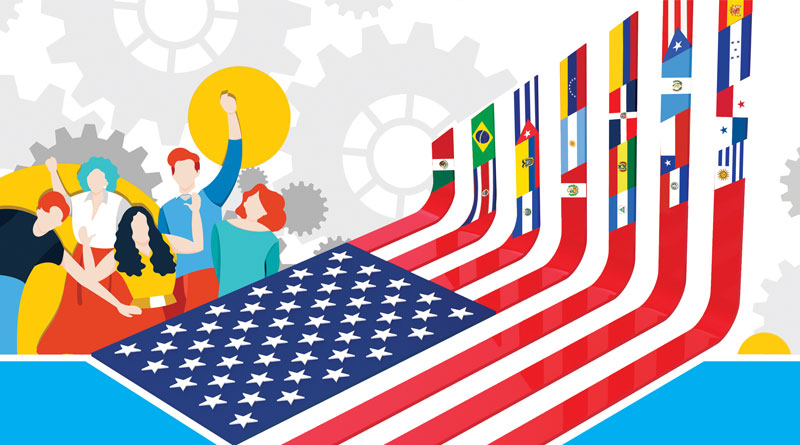The Evolution of Hispanic Heritage Celebration
“Latinos: Prosperity, Power and Progress”

By: Maria Alejandra Pulgar
@marialepulgarwrites
The celebration of Hispanic Heritage Month in the United States, every year from September 15th to October 15th, has evolved along with the prosperity, power, and progress of the Latino population.
What was conceived as an event to raise awareness in the general public about the historical contributions of Hispanics to American society has morphed over the past 20 years into a celebration of their accomplishments, empowerment, education, and traditions. This is the moment to review the present and estimate the future influence of Hispanics in American society.
According to the US Census in 2020, the Hispanic population reached 62 million, a 75% increase in the last 20 years. With that, Latinos became 18.7% of the American population, and it is projected it will reach 128 million (30% of the population) by 2060. Hispanics are the “nation’s second-largest ethnic or racial group,” according to Pew Research, reshaping the demographics and, in consequence, its influence and impact in all aspects of society.
The greatest strength of Hispanics is their diversity, which enriches their cultural and economic contributions to America. In addition to sharing the Spanish heritage and language, the fact that they come not only from neighboring Mexico but from different countries in the Caribbean, Central and South America, makes Hispanics a multiverse of dialects, cultures, and traditions that has finally transcended what was stereotypical Latino for many Americans in the past.
Hispanic immigrants and Americans of Hispanic descent are “stirring up the melting pot” that is the US, and they have achieved great strides over the years, making economic and social progress, increasing their political influence, and contributing to the prosperity of the whole country.
“We are One”: Celebrating Hispanics’ Diversity
This year’s motto for Hispanic Heritage Month is “We are all, we are one.” It reflects the diversity of the Hispanic community, with the common thread of the Spanish language. It has taken a lot of effort and communication over the years to make Americans understand the cultural mosaic that Hispanics create, with their different backgrounds depending on their countries of origin.
Spanish colonization of Latin America was a complex process; whereas in Mexico, Central America, Peru, and Colombia, there are rich indigenous influences. In the Caribbean, the Spanish, indigenous, and African cultures mixed, creating unique customs, music, cuisine, and traditions in each country.
According to the most recent Pew Research report, the five largest Hispanic populations in 2021 in the U.S. by origin group were Mexicans, Puerto Ricans, Salvadorans, Dominicans, and Cubans; Venezuelans were the fastest-growing group in the last ten years, increasing their population by 169% for a total of 640,000.
Hispanics are not a monolithic group, and while some “are proud of their heritage and culture, other groups face discrimination and assimilation pressures”. There has been progress, and still, there is work to do to assist Hispanics in their incorporation into American culture without losing their uniqueness.
Economic Progress, Cultural and Political Influence
The greatest strength of Hispanics is their diversity, which enriches their cultural and economic contributions to America. Hispanics are conscious of the need for assimilation to achieve progress and success in the US. Therefore, they place the focus on that task: 72% of the total Hispanic population is proficient in English, and 81% are US citizens, either by birth or naturalization.
Family stability and education are strong values for Hispanics that impact their communities and strengthen their economic progress and influence: 57% live in a married couple household; 56% have achieved or completed high school, and 20% have a bachelor’s degree or above. Financially, Hispanics have improved their status as well in the past ten years: the median annual household income is $59,000; 51% own a home, 62% are employed, and only 18% live below the poverty line.
The influence and visibility of Hispanics in different sectors of society “have made significant contributions to the arts, sciences, sports, politics, business, education, media, military and more”. More and more Hispanics are achieving relevant positions and conquering spaces. Names like Justice Sonia Sotomayor, Astronaut Ellen Ochoa, Artist Lin-Manuel Miranda, or Vice-Governor Jeanette Nuñez serve as references for young Hispanics of the places where they can aspire to reach with work and dedication.
The Hispanic population is an important political base for elections and it is notorious the effort to reach out to them made by non-Spanish speaking politicians. The demographic change is reflected in the US Congress, where the number of members of Hispanic descent has grown, with senators and representatives who advocate for the needs of their diverse community.
The work ahead
The evolution of the Hispanic Heritage Celebration over the past 20 years reflects the growth and influence of the Hispanic community. They continue gaining space and representation in all aspects of American society. There is still work to do, but the increase of the Hispanic presence in the US is no longer quiet but active and fundamental for the country’s success. In the diversity and richness of Hispanic contributions lies a strong commitment to support the future and success of the United States.

